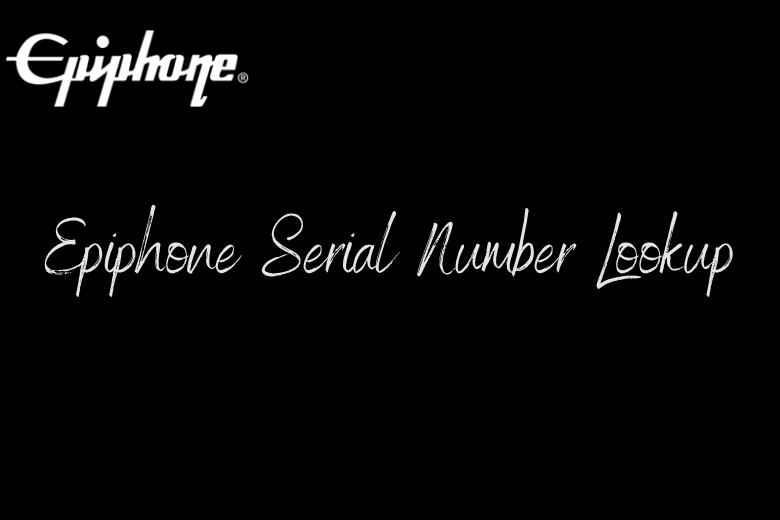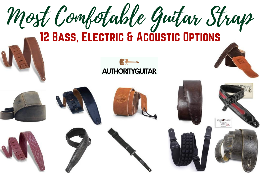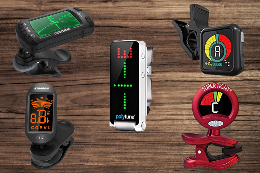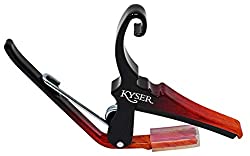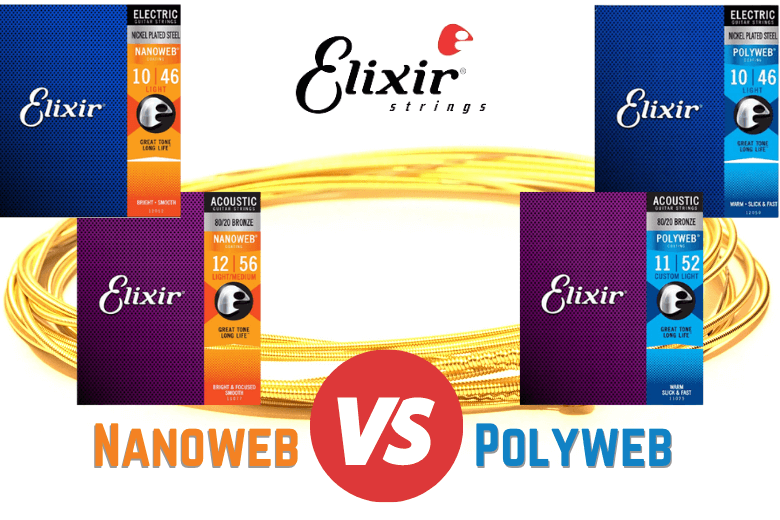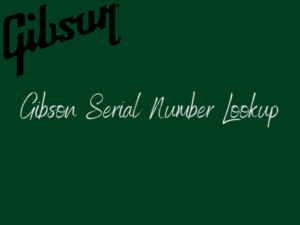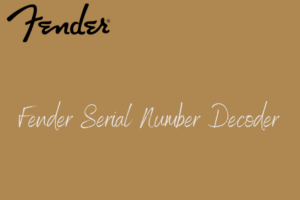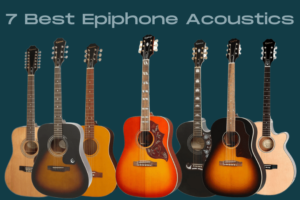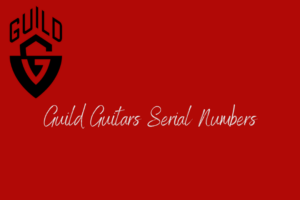Discovering your guitar’s history can be a very rewarding thing to do. Authority Guitar has collated a mountain of data to give you the history by using your Epiphone Serial Number Lookup.
Your guitar’s journey from the factory into your hands may be a mystery, but it’s always a good way to dig into the earlier life of your instrument.
It’s also essential to have the correct information if you’re considering buying or selling a guitar. Researching a guitar’s serial number can also stop you from being the victim of fraud.
It’s simple enough with our Epiphone Serial Number Lookup Decoder. Type your serial numbers into the decoder below and you’ll get all the information Epiphone has on the instrument.
If you end up with an error message, please scroll down and find your guitar’s credentials manually using our helpful number grids.
*We’ve tirelessly searched the internet for every record, the information gathered is the most accurate we could find. Some documentation crosses over and some has been lost over the years causing gaps in our data.
Where Do You Find Your Epiphone Guitar Serial Number?
You’ll find Epiphone serial numbers in the standard places.
Electric guitars having the serial number on the back of the headstock. Semi-hollow guitar serial numbers are found inside the ‘top’ F-hole on a label. Acoustic guitars are punched inside the soundhole on a sticker behind the strings.
On rare occasions, some dates can be found on the electric guitar pots. In a lot of cases if you cannot find any serial number details. This would be the place to look.

Need Accessories?
There are many accessories and extras guitarists need from time to time. Some out of necessity, or maybe we just fancy something fresh and new to play with. Here are all your guitar essentials.
Epiphone Serial Number Lookup Decoder
Authority Guitar Top Tip: If you find your serial number doesn’t yield any results, press ‘crtl & f’ and enter the beginning of your serial number. This page will then be highlighted in all the results starting with the numbers/letters you’ve entered. Scroll down to our ‘Manual Checklist’ and you’ll almost certainly find a serial number very close to your own. Giving you a general idea of when your guitar was manufactured.
Best Epiphone Acoustic Guitar: You Can Own One For Less Than You Realize

Epiphone Guitar History
Let’s start the story with two incredible details you probably didn’t know about Epiphone.
Les Paul, yes the man himself worked nights at Epiphone on a guitar he dubbed ‘the log’. Whatever happened to that design I wonder? He later called it the ‘Les Paul!’
Also, Paul McCartney’s first American made guitar, was the beautiful Epiphone Casino. Later John and George followed suit, and they can be heard from the album Abbey Road onwards.
Let’s go back to 1873. A manufacturing business was founded by a certain Anastasios Stathopoulos, in a Greek city named ‘Smyrna’.
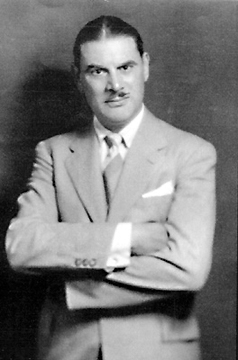
Around this time Anastasios’s son was a 12-year-old interested observer.
By 1908 the family business moved to New York City.
Epaminondas Stathopoulos, the son of Anastasios took over and renamed the organization ‘Epiphone’. Epi- after his own nickname, and phone from Greek phon-‘voice’. Also an echo of the Greek expression ‘epiphonous’. Translating to ‘one sound on another’, a son acting on the dreams of his father.
After the death of his mother in 1923, Epi took sole control of the organization and devoted all the energy to the sole production of the banjo. Banjo mandolins, banjo guitar, and the banjo mandolin.
All instruments would now be manufactured under the umbrella of Epiphone, at the companies headquarters in Long Island NY.
In 1927 production steadily increased and the quality of instruments improved. Elegant Banjo models were brought in. Such as the Emporer Tenor Banjo, the Dansant, the Concert Special, and lastly the Alhambra.
This was a very successful part of the business, Epi and his brother Orphie (Vice President) moved the company to new pastures, 235-237 West 47th Street.
1928 Epiphone are producing banjos for major distributors in Selma Conn and Continental Music stores. During this period Epi brought in the early design of the Epiphone Acoustic Guitar.
The first acoustic guitars were made from laminated maple and spruce top wood. Available in Archtop or Flattop designs.
The origins of the Epiphone acoustic guitar were unfortunately not a success. This was partly down to the fact they had no mainstream celebrity musicians to endorse the guitars.
Some negative feedback followed, some players were stating the lack of volume and the small size. This was in comparison to the very popular Gibson L-5. Epiphone was battling against the industry standard.
The Gibson L-5 had superb projection, a huge tone that fitted well into the rhythm section of many well-known artists of the time.
1931 was a big year for Epiphone. Announcing the release of the Masterbilt line. This range of acoustic guitars would feature the De Luxe, Broadway, and the Triumph.
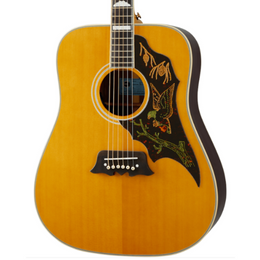
These guitars struck a canny resemblance to the Gibson L-5. The Epiphone Masterbilt line was of violin construction, with included large F-holes and a sweet resonant tone.
The beginning of the 30s was a tussle in sales between Gibson and Epiphone. By the mid-1930s the Epiphone name was considered to be one of the best instrument manufacturers around.
1935 Epiphone released the Electa Series. The electric steel guitar was a success with its unique adjustable pole piece on the master pickup. Showing off the skill of innovative ability of their craftsmanship.
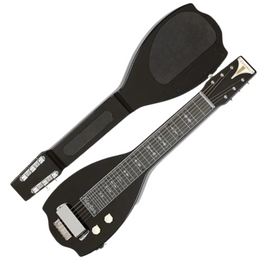
In 1936 Epiphone starting producing amplifiers. A friend of Les Paul by the name of Nat Daniel was an electronics expert. Nat went on to start production of the Danelectro line of guitars and amps in the 50s.
World War II hit Epiphone hard. At the beginning of the war, Epiphone was the leader in the industry. By the time the war was over in 1945, the empire didn’t recover. Epaminondas Stathopoulos, unfortunately, suffered from leukemia and passed away.
The shares and total control of the business were handed over to the younger brothers, Orphie and Frixo.
There would be a downturn in the Epiphone dynasty. The brothers would disagree on the direction of the company. Ending in Frixo selling his shares to Orphie.
The reputation and craftsmanship Anastasios and Epi had built in days gone by didn’t last. The public’s taste in instruments changed, leaving Epiphone out of touch with its audience. This is turn took its toll on sales.
1957 was a huge turning point for Epiphone and its dying company. Les Paul, now a successful radio and TV star suggested to Gibson president (Ted McCarthy) should look into investing in the popular Epiphone upright bass division.
Gibson’s own upright bass branch had not been picked up since the end of the war (1945).
Negotiations got underway and eventually, McCarthy had a $20,000 offer accepted for the whole of the Epiphone Enterprise. This was the end of the instrument manufacturing business for the Stathopoulo family.
McCarthy’s clever business plan was to offer Gibson-made Epiphones to dealers to prove themselves as profitable affiliates to Gibson. Thus giving the successful dealers a chance to sell the hotly contested and popular Gibson range.
At this point, the entire Epiphone organization was switched to the world-famous Kalamazoo MI factory.
Gibson now owned the Epiphone name and most of its staff. And because of this the old Epiphone classics in the shadow to Gibson for a long.
1958 saw the rebirth of the successful Epiphone range. The Emperor, Deluxe, Triumph were back. The newer Sheraton and solid body Moderne black were also a huge success. Flat-top acoustics like the Frontier was a match for any instrument currently on the Gibson line.
The 1960s saw the eruption of folk music. Epiphone models were already a perfect fit for that genre.
1966 saw The Beatles showing up on tour playing Epiphone Casinos.
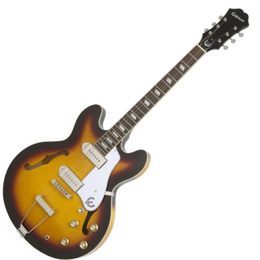
Due to stiff competition from overseas, Epiphone moved its manufacturing to Japan in 1970.
Aria oversaw the production. The traditional popular designs of the past were ceased in place of cheaper models with unspecified wood types. The older models were losing its value and continuity.
1983 Saw the brand move again to Korea. Samick was licenced by Gibson to make more affordable models of Gibson classics. Giving Epiphone a boost it needed. Plastic nuts, less expensive hardware and bridge was also added.
Qingdao, China is the most recent factory where Epiphones are now produced. Gibson aquired this factory in 2004.
Interestingly enough, Qingdao China is the factory Epiphone re-introduced the line of Masterbilt guitars. This range was the beginning of the Epiphone acoustic battle with Gibson from the 1930s.
Epiphone Serial Number Lookup – Manual Checklist
Here is a summary of the serial number, model, and year. To gain the best results use our decoder above.
*Authority Guitar Top Tip: Press ‘ctrl & F’ then add the beginning of your serial number/guitar model in the search bar to find your details quicker on our extensive list below.
To reveal an accurate date of the serial numbers below, add your details to our Epiphone decoder.
11 Digit Serial Numbers
11 digit serial combinations originate from the factories DeaWon/Unsung/Qingdao in China or Unsung-Korea or Samick-Indonesia. Both Electric and Acoustic Instruments were produced here.
This ‘generally’ is the pattern: year/year/month/month/factory id x2/production number x5)
As the complexity of the serial format changes throughout the destinations, its best to use our serial number decoder, as you stand a good chance of receiving a date also (month & year).
5 Digit Serial Numbers
Custom Shop. 1990-1999
5 Digit Serial numbers within this particular arrangement: X_XXX are Custom Shop Guitars from the years 1990-1999. The first digit is usually the ‘year ending’ in.
Acoustic and Electric, 1951-1956, 1961-1967
5 Digits like the following: XXXXX are from the years 1951-1956 or 1961-1967. Both Acoustic and Electric models.
6 Digit Serial Numbers
1961-1970
6 Digit rows: XXXXXX are produced from the years 1961-1970
*Although 6 digit serial numbers starting with a ‘0‘ (0XXXXX) were manufactured from 1967
7 Digit Serial Numbers
1984-1995
7 Digit Serial numbers have a mixture of the date included within it. Between 1984-1995 the guitars were manufactured from the Samick Factory in Korea.
Use our decoder to receive your exact date.
8 Digit Serial Numbers
1990
8 Digit Serial numbers as follows XXXXXXXX. Are from the Samick Factory Korea.
9 Digit Serial Numbers
1988
9 Digit Serial numbers as follows XXXXXXXXX. Are from Samick, Korea.
Factory Letters
Serial numbers that start with a letter
Its difficult to predict how many digits follow a letter in the serial combination. All we have at this point, if the letter the serial details start with.
The following letters have the following place of manufacturing bound to them according to our online research:
As always use the Epiphone decoder to full details
T Serial
6 Digits- 2002+
China
We are certain the following letters at the beginning of the serial codes are from a number of factories in China.
Letters : BW,DW,EA,ED,EE,GG,GR,H,MC,MR,QG,SJ,UC,Z,HW,F & X
Korea
Letters :
C,I,K,O,P,R,S,SM,U,GP & JK
Indonesia
Letters :
CI,IS,SI & SN
F Serial Numbers
There are many variations of the serial data that begins with the letter F. Here is as much information as we have.
We have a mixture of models from Japan and China.
Use our decoder to get exact factory and instrument details (if available)
F123456 = Fuji Gen, Japan.
F1234567 = Fuji Gen, Japan
F Serials manufactured in China:
| Serial Number |
|---|
| 300000-305000 |
| 305001-310649 |
| 310650-311051 |
| 317000-323999 |
| 324000-330000 |
| 330000- |

